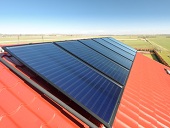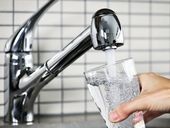The amendment of the Water Act will be effective as of 1-8-2010, and contains a number of innovations. Current topics: Cesspools, sewage treatment plants only on notice, discharge of effluents from small sewage treatment plants through soil layers to underground water, rainwater, hydrogeology report, residual flow in streams.
Archiv článků od 19.10.2009 do 14.6.2010
In the first part of the article is a brief overview of the market of collectors of solar radiation in the Czech Republic, the basic layout of different types of collectors and major part of solar systems. Following parts provide some basic connection of solar systems for various heating load (hot water, heating, swimming pool) and a simplified design absorber area. Each scheme is briefly described its function. In conclusion, it is marked possible connections of storage tanks for different performance.
The report is focused on analysis earthing of mains and earthing like unit including building services engineering. Safety function of earthing, requirements, practic application and realisation supported by ČSN (Czech Technical Standard). It shows earth electrode project and bonding protection of services engineering in buildings. Function, principles including bonding realisation is supported by Czech Technical Standard and pictures. Report is supplemented description of additional protection – complementing bonding protection internal water supply systems.
The current Czech standards sets different requirements on the location of safety valves. Article provides an overview of requirements. Safety fittings are elementary for the safe operation of equipment and for protect the health and wealth. It is necessary that the requirements are consistent and correctly calculated. Because the requirements of European standards prevail, it is necessary to change the independent Czech standards.
From the point of view of national legislation, solar collectors are considered construction products and so, before being put on the market, must meet the requirements of Law no. 22/1997 “on technical requirements for products and of amending and supplementing certain laws, as amended, laying down technical requirements for products”. These requirements are specified in the Decree no. 163/2002, which lays down the technical requirements for specific buildings products, as amended by the Government Regulation no. 312/2005. Solar collectors are listed as Item 7 in Table 10 (technical equipment of buildings), in Annex 2 - “Equipment for heating spaces with no energy source a) in buildings b) for use, which are subject to required reaction to fire with specific levels ”
This paper contains a proposal involving basic thermal calculations and how to manage water heating with a heating plate in hot water tanks. Heating plates are chosen because water heating can be clearly described from without the tanks with conventional heating relations, and designers can easily calculate all parameters. Tanks are used because they can reduce the heat output of the generators. We are speaking in this case about gas condensing water heating boilers.
The article describes the experiment of verifiable possibilities for using nano-textile materials in the field of microbiological filtration of polluted water. The main advantage of this procedure to clean contaminated water is the total absence of chemical products, which would later remain in the disinfected water if chemical cleaners were used and could contribute to the degradation of biological reactions in the organism. The experimental results have not confirmed the theoretical assumptions that the size of the pores of the selected nano-textiles would prevent the passage of bacteria. The filtered liquid, with the exception of PUR, was filtered through a nano-textile, yet the evaluation still showed bacteria contamination. Stronger nano-textiles with PUR were not appropriate for filtration due to their impermeability (much too large a layer). When three layers of PA612 were used a different number of colonies before and after filtration were recorded. After filtration, the number of bacteria was reduced by two orders. Although that amount of microbiological contamination is still harmful to the health, the technology organisation of the filter may indicate the direction in which further action can be taken.
As of the 1st Octo 2009 is in force in the Slovak Republic the decree 311/2009 Z.z., which lays down the details for he calculation of the energy performance of buildings and the contents of the energy certificate. It is a binding document resulting from the law 555/2005Z.z., in which the Directive 2002/91/EC on the energy performance of buildings is implemented.
The article describes a specific installation. This heat pump is installed in a family house in Pinkafeld, Burgerland, Eastern Austria. According to the recorded data, the energy flow of the heat pump was evaluated and the seasonal values of the heating factor in the hot water were determined during a period of one and a half years. The results of heat pump's water antifreeze mix show that the water heating corresponds to current energy demands and economical operation.
This article provides an overview of standards that must be taken into account when projecting, preparing and installing internal drainages. The standard BS EN 12056-1 to 5 (75 6760): 2001 Buildings - Gravitational Systems, together with the residual original Czech standard CSN 75 6760: 2003, Internal Drainage should be considered the most important, as well as BS EN 12109 (75 6761): 2000 buildings - Vacuum Systems. Other standards address the evacuation of water containing hydrocarbons, fats, water treatment plants and testing facilities for sewage and sanitation.
This article provides an overview of standards that must be taken into account when projecting, preparing and installing internal water supplies. The most important to be considered is BS EN 806, which is already in parts 1,2,3, with other 2 parts still pending. At the moment the original Czech standard ČSN 73 6660 Interla Water Supply, is only being adjusted. Its overall review will be undertaken only after all parts of BS EN 806 have been published. From the list of standards, it is also possible to choose CSN 75 54 55. Calculation of Internal Water Supply, and CSN 06 0320 for the design and calculation of the disposition of hot water.
As in the rest of the EU Member States, the Directive 98/83/EC for drinking water requirements is also valid for the Czech Republic, but our country has also used the opportunity provided by this directive to set even more strict requirements for the quality of drinking water with the inclusion other indicators among the mandatory monitoring indicators. Different countries choose different procedures and strategies to reduce exposure to lead in drinking water and meet more strict requirements on its contents. The Czech Rep. is in a path of gradual replacement of lead materials. In addition to the initiatives of individual water supply companies aimed at replacing lead pipelines, there is a national program to promote their replacement in internal water supplies.
The second part of the article focuses particularly on water and gas supply plumbing. For the water supply plumbing the current need for metering must be taken into account and the location of the meters resolved. Changes occurred also in the pipelines and materials. Old gas supply lines can be problematic in terms of the dimensions and tightness of the pipelines. There will be vital changes in the requirements for the location of main valve and gas meters. The renovations will require the most accurate survey and carefully prepared project. In order to have a successful renovation, improvisation in the construction works must be most limited.
The renovation of the so called "Panel Buildings" is currently the centre of attention. This creates the impression that renovation and modernisation are only necessary for this type of buildings, while others, often much older blocks of flats, are not in need of renovations. The renovation of the sanitary installations in old brick buildings is often much more difficult because the ascenders and waste pipes are not located in shafts. Most pipes are right under the plaster or under the floors on underground floors. The materials of plumbings that can be found in these buildings are gradually reaching the end of their lifespan. In buildings dating from before WWII we often come across obsolete and usually unsatisfactory lay-outs for the sanitary installations.
zpět na aktuální články

